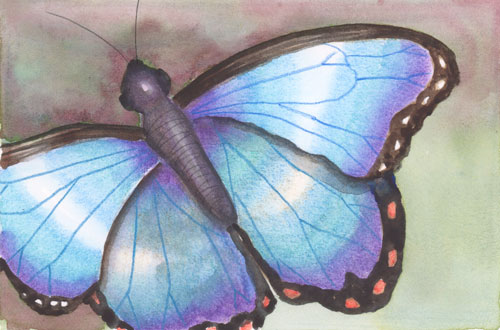Where’s your Waldo? Seriously, it’s all about location – location – location.
I read somewhere, I don’t remember, that your background should be interesting with your main characters removed.
 What makes an illustration appropriate for a children’s book as opposed to an advertisement or package art is the story telling ingredients. This butterfly is an illustration I did as a demo for my students during my Techniques of Watercolor Pencil class. It’s pretty, it has a focal point and a background. But it is completely lacking in story telling and the background could be anywhere. As an illustration for a children’s book it is a failure.
What makes an illustration appropriate for a children’s book as opposed to an advertisement or package art is the story telling ingredients. This butterfly is an illustration I did as a demo for my students during my Techniques of Watercolor Pencil class. It’s pretty, it has a focal point and a background. But it is completely lacking in story telling and the background could be anywhere. As an illustration for a children’s book it is a failure.
What would change that? In connection to this post, having this blue beauty in a specific type of tree, perhaps with a frog or other butterfly eating creature lying in wait for a yummy meal. That gives the image, the main character – in this case, the butterfly, a story and something to draw the viewer into the image.
I hope you’re not filling your portfolio with lots of pretty pictures of kids or kittens calmly staring at the viewer on a white or plain background.
Being a good artist isn’t enough to be a children’s book illustrator. Being a great artist isn’t either. Your job, mission, journey as a book illustrator is to tell that story in 1,000 words with no words at all.
Let’s say you have a little boy holding a ball.
Location – location – location.
Where is this boy? What is he wearing? Where did the ball come from? These are only the beginnings of the questions you need to ask yourself when sketching out an image appropriate for a picture book. Interview that character. Ask him why he has the ball, what he plans to do with it, and where he plans to do it.
If you decide he’s going to the park to play catch with his dad, that’s great. But don’t stop there. Where is this park, what is the weather like, is it crowded? Does the dad live with the boy or is he a weekend visitor, maybe he’s on leave from the Armed Forces. Will there be other little boys at the park for him to play with? Depending on the time of day, such as after lunch or during dinner time, will create two very different environments, even in the same park.
Take a look at the images in your portfolio. If you take your main character out of the picture, literally, is there still a story going on without him or her? If the answer is no, you have your work cut out for you.
Once you have your storyline in mind, you’re halfway there. Yes, only half way.
Having a place in mind is only part of what needs to be portrayed. The other half, the important half is making this place, this environment specifically yours. A generic park just wouldn’t have the same impact as the one where your grandma took you to. What made that park special, what makes it stand out from any number of other parks you’ve been to in your life?
Location – location – location.
A list of 10 places a story might take place:
- Kitchen
- Basement
- Rooftop
- Abandoned building
- Swimming pool
- National monument
- State fair
- Seashore
- Zoo
- Shoe store
The list can go on from there. A generic location can become a powerful visual story telling tool. It’s up to you as the illustrator to take it to the next level and make it individually and interestingly yours and yours alone. Happy painting!
____________
If you found this post helpful and are interested in receiving notifications when more portfolio builder advice is posted,
sign up for my mailing list.


 RSS - Posts
RSS - Posts
Thank you Wendy for pointing out these “specifics”! You are so right about the job of an illustrator and how much you have to ask your characters what they are doing and why and so on…Opens up a whole new world when you keep asking questions. Thanks so much again.
I agree with the others. They probably seem very obvious to seasoned pros but these tips are another helpful piece to the puzzle for illustrators who are learning on their own.